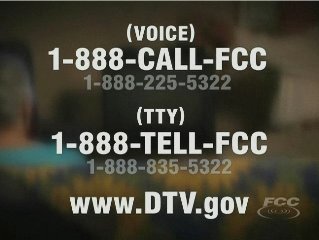By Daria Belov
After a four-month delay, the dtv countdown clock has expired, and the digital transition date is today — June 12, 2009. If you have an analog TV, it’s time to get a government coupon for a digital conversion box, so you can buy a converter and make the switch to digital. If you’ve gone online today searching to find out “what’s wrong with my TV” you certainly won’t be alone. While there’s been a coordinated nationwide effort taking place for months, to educate consumers about the switch from analog to digital TV, millions of Americans may still not have gotten the word that today is the day to flip the digital switch.
 (photo: 888-CALL-FCC or www.DTV.gov)
(photo: 888-CALL-FCC or www.DTV.gov)
Use the phone number on the screen to the left to call the Federal Communications Commission’s help line for conversion to digital television. You can also visit the website at www.dtv.gov.
Many people may have thought that the DTV transition deadline was on February 17, but Congress passed the DTV Delay Act, which extended the deadline for full power broadcast television stations to complete the conversion to digital transition on June 12. The change allowed more time for us to be prepared for digital transitions, but there’s a good chance that you or someone you know, still has not made the switch.
At ADIO Chiropractic in LA, I don’t think Dr. Michael Dorausch got the message, as we prepared for conversion day at the office by ordering a government coupon for a dtv conversion box. Before we bought the conversion box, Dr. Mike went and threw away the television. Actually, he left it outside and somebody happily took it. It was working just fine, but I suspect we’re now getting a fancy Digital LCD screen TV for entertaining our chiropractic patients and staff (hint hint).
Back in May, a record number of consumers called the Federal Communications Commission (FCC) national helpline, when a nationwide “soft test” was run to encourage people to take immediate action in preparing for today’s digital television (DTV) transition. The test resulted in a single day record of 55,000 calls to the FCC’s help line, a call center that had received approximately 15,000 calls a day since May 1. You’re probably better off searching for solutions online, versus calling a hotline.
The DTV.gov website has pages upon pages of information related to making the digital transition. They’ve got simple , easy-to-follow steps, that explain getting a box, buying a box, installing the box, and fixing any reception problems. Some of the most common questions being asked include the following…
Can I Still Use My Old Analog TV Set for DTV? — Your analog TV set will not be obsolete once the transition to DTV is completed, but to ensure continued use of your analog set, you must either use a digital-to-analog converter box or connect to a subscription service such as cable or satellite TV.
Can I Use My UHF/VHF Antenna to Receive DTV? — Yes. Television stations broadcasting in digital use both the VHF (channels 2-13) and UHF (channels 14-51) bands. Many indoor antennas use “rabbit ears” for the VHF band and a “loop” antenna for the UHF band. If you want to get more than channels 2 through 13, make sure your antenna covers both bands, and make sure you’re connected properly.
Does the DTV Transition Affect TV sets that are connected to cable services like DirecTV or Dish Network? — No. If you subscribe to cable service, the DTV transition should not affect any TV sets that are connected to your cable services. The DTV transition applies only to full-power broadcast television stations – stations that use the public airwaves to transmit their programming to viewers through a broadcast antenna.
To answers for lots of other digital transition questions, be sure to check out the FAQ section on the Government DTV website. There is also a troubleshooting guide, information about broadcasting television stations across the US, localized support centers, and do-it-yourself videos. Speaking of do-it-yourself videos, there are several videos on YouTube showing instructions on how to build HDTV antennas. This is something different than the digital conversion boxes, but if you’re looking to improve TV reception, you may want to check out some of these videos as well. The one shown here is how to build an HDTV antenna using coathangers.
Again, that video is for a do-it-yourself HDTV antenna, not a digital converter box. There’s lots of other videos like how to hack a digital converter box, but you can search around online and probably find plenty of videos for improving your televisions new digital reception.
Remember, if you’re going to be watching TV, make sure you’re maintaining good viewing posture. It will make your chiropractor (and your mom) happy.
planetc1.com-news @ 2:55 am | Article ID: 1244800555




Comments are closed for this article!